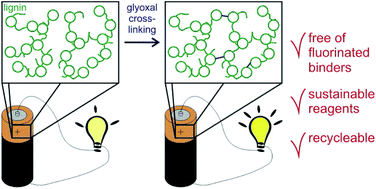当前位置:
X-MOL 学术
›
J. Mater. Chem. A
›
论文详情
Our official English website, www.x-mol.net, welcomes your feedback! (Note: you will need to create a separate account there.)
More sustainable energy storage: lignin based electrodes with glyoxal crosslinking
Journal of Materials Chemistry A ( IF 11.9 ) Pub Date : 2017-11-02 00:00:00 , DOI: 10.1039/c7ta07686j S. Chaleawlert-umpon 1, 2, 3, 4, 5 , C. Liedel 1, 2, 3, 4
Journal of Materials Chemistry A ( IF 11.9 ) Pub Date : 2017-11-02 00:00:00 , DOI: 10.1039/c7ta07686j S. Chaleawlert-umpon 1, 2, 3, 4, 5 , C. Liedel 1, 2, 3, 4
Affiliation

|
Lignin is a promising material to be used in sustainable energy storage devices. It may act as an active component due to hydroquinone motifs or as a binder in electrodes. While usually it is blended or modified with unsustainable chemicals, we investigate crosslinking with glyoxal as a new route to obtain more benign electrodes. For combining the advantages of high charge (lignin as an active material) and electrode stability (lignin as a binder), we chose a two-step process in which we first form lignin–carbon composites and subsequently crosslink lignin on the carbon. We discuss crosslinking of the material as well as influences on charge storage. Final electrodes benefit from combined faradaic and non-faradaic charge storage and reach a capacity of 80 mA h g−1 at a discharge rate of 0.2 A g−1.
中文翻译:

更可持续的能量存储:带有乙二醛交联的木质素基电极
木质素是可用于可持续能源存储设备的有前途的材料。由于对苯二酚的图案,它可以充当活性成分,也可以充当电极中的粘合剂。虽然通常将其与不可持续的化学品混合或改性,但我们研究了与乙二醛的交联作为获得更多良性电极的新途径。为了结合高电荷(木质素作为活性材料)和电极稳定性(木质素作为粘合剂)的优势,我们选择了两步工艺,首先形成木质素-碳复合材料,然后在碳上交联木质素。我们讨论了材料的交联以及对电荷存储的影响。最终电极受益于法拉第和非法拉第组合电荷存储,在放电速率为0.2 A g -1时达到80 mA hg -1的容量。
更新日期:2017-11-15
中文翻译:

更可持续的能量存储:带有乙二醛交联的木质素基电极
木质素是可用于可持续能源存储设备的有前途的材料。由于对苯二酚的图案,它可以充当活性成分,也可以充当电极中的粘合剂。虽然通常将其与不可持续的化学品混合或改性,但我们研究了与乙二醛的交联作为获得更多良性电极的新途径。为了结合高电荷(木质素作为活性材料)和电极稳定性(木质素作为粘合剂)的优势,我们选择了两步工艺,首先形成木质素-碳复合材料,然后在碳上交联木质素。我们讨论了材料的交联以及对电荷存储的影响。最终电极受益于法拉第和非法拉第组合电荷存储,在放电速率为0.2 A g -1时达到80 mA hg -1的容量。


























 京公网安备 11010802027423号
京公网安备 11010802027423号